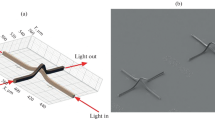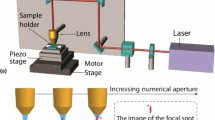Abstract
Molecules exhibiting strong two-photon absorption hold great potential for a wide range of applications including two-photon fluorescence imaging, three-dimensional (3D) optical data storage, and 3D microfabrication. We have observed two-photon absorptivities as high as 1500x10-50 cm4 s/photon in bis-donor diphenylpolyene derivatives that are correlated to simultaneous charge transfer from the end groups to the polyene bridge in the molecule. Many of these molecules are also excellent photoexcitable electron donors that can initiate charge-transfer reactions with acrylate monomers. Marcus theory is used to describe the efficiency of these charge-transfer reactions. Polymerization rates have also been measured and we show that these twophoton chromophores display increased sensitivity and recording speed over conventional UV photo-initiators. The fabrication of complex, three-dimensional structures by twophoton polymerization is demonstrated and discussed in the context of advanced photonic applications.
Similar content being viewed by others
References
J.H. Strickler and W.W. Webb, Optics Letters, 16, 1780 (1991).
J.H. Strickler and W.W. Webb, SPIE Proceedings, 1398, 107 (1990).
E.S. Wu, J.H. Strickler, W.R. Harrell, and W.W. Webb, SPIE Proceedings, 1674, 776 (1992).
S. Maruo, O. Nakamura, and S. Katawa, Optics Letters, 22, 132 (1997).
C. Xu and W.W. Webb, J. Opt. Soc. Am. B, 13,481 (1996).
R.J.M. Anderson, G.R. Holton, and W.M. McClain, J. Chem. Phys., 70, 4310 (1979).
Manuscript in preparation.
J.R. Bolton and M.D. Archer, "Basic Electron-Transfer Theory", in Electron Transfer in Inorganic, Organic, and Biological Systems, J.R. Bolton, N. Mataga, and G. McLendon, eds., Advances in Chemistry Series, 228, American Chemical Society, Washington, D.C. (1991).
G. Odian, Principles of Polymerization, John Wiley & Sons, New York (1981).
J.D. Joannopoulos, P.R. Villeneuve, and S. Fan, Nature, 386, 143 (1997).
Acknowledgement
This work was performed in part at the Jet Propulsion Laboratory (JPL), California Institute of Technology as part of its Center for Space Microelectronics Technology and was supported in part by the JPL Director's Research and Development Fund and the Ballistic Missile Defense Organization, Innovative Science and Technology Office, through an agreement with the National Aeronautics and Space Administration. Support at Caltech from the Office of Naval Research through the Center for Advanced Multifunctional Nonlinear Optical Polymers and Molecular Assemblies, the National Science Foundation, the Office of Naval Research, and the Air Force Office of Scientific Research is gratefully acknowledged. We thank Sartomer, Inc. for providing us with various acrylate monomer materials used in this study.
Author information
Authors and Affiliations
Rights and permissions
About this article
Cite this article
Cumpston, B.H., Ehrlich, J.E., Erskin, L.L. et al. New Photopolymers Based on Two-Photon Absorbing Chromophores and Application to Three-Dimensional Microfabrication and Optical Storage. MRS Online Proceedings Library 488, 217–225 (1997). https://doi.org/10.1557/PROC-488-217
Published:
Issue Date:
DOI: https://doi.org/10.1557/PROC-488-217




